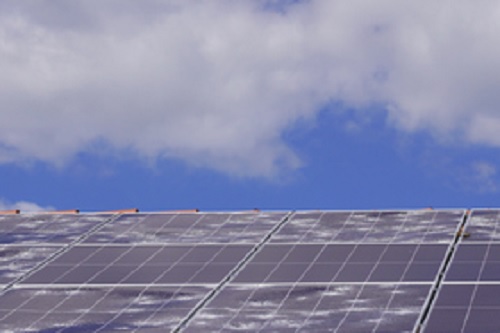Hail resilience – key challenges and mitigation options for utility scale Solar Farms

Growth of Utility Scale Solar Photo Voltaic (PV)
The abundance of sunlight available daily makes it a very attractive, sustainable, renewable energy resource. This has led to a massive growth of utility-scale, ground mounted, Solar Photo Voltaic (PV) farms all over the world, as it’s a cost effective and quick to install renewable energy solution, given economies of scale and continuous innovation throughout the supply chain. It’s predicted that installed global PV capacity will reach 2.3TW by 2025. The rapid geographical spread of solar PV farms globally, especially in remote areas, makes them very vulnerable to extreme weather such as hail in certain parts of the world.
Hail exposure
As the effect of climate change gathers pace, extreme weather, in particular severe hailstorms, are now becoming more common and are having a greater impact in certain countries, whereas previously this wasn’t the case. In addition, utility-scale Solar PV farms are now becoming very large, requiring vast amounts of land, which has led to them being built in more remote areas that are more prone to hailstorms. In the last few years, several notable extreme hail events have occurred, particularly in the Southern United States, where in one instance, hail several inches across caused extensive damage to the PV panels at a utility-scale solar site.
Solar panels are particularly vulnerable to hail as the glass panel covers of the photovoltaic (PV) modules are easily damaged from its impact. The damage ranges from microcracking of the glass panels, which exposes the PV modules underneath to moisture, to extensive destruction such as large holes being punched through the solar panels rendering them inoperable. In certain circumstances, damage could lead to short circuiting of the solar PV modules causing localised overheating and in some cases resulting in fire. As the scale of ground mounted, utility-scale, solar PV development and installation has gathered pace, so too has the level of exposure of these sites to hailstorms. Over the last few years, large ground mounted utility-scale solar farms, particularly in the United States, have suffered extensive damage across a wide area of the site following a severe hailstorm, leading to tens of millions of dollars in property damage and lost power production revenue.
Industry reaction to date
The solar PV sector has recognised the threat of severe hailstorms and has been implementing measures to improve the resilience of solar panels to hail-induced damage. Hail impact testing and certification for PV panels under UL 61730 or international equivalent IEC 61730, evaluates the ability of the PV panel under test to withstand one-inch to three-inch hailstones travelling at speeds between 17mph – 88mph at 90° with respect to the panel orientation.
Smart solar PV single or dual-axis tracking systems equipped with monitoring and control software have been developed to stow or reorientate the angular position of the solar panels to a safe position. The stow position could be a high or low tilt to deflect the impact force from hail with high-tilt angles offering better protection. However, the optimum tilt angle is a compromise between hail protection and preventing the panels from lifting during a high wind event. Extreme weather prediction software has also been developed to provide early warning of incoming hailstorms to allow solar PV asset owners to deploy their own mitigation measures, such as activating trackers to move to their safe stow position or using protective covers as shielding. It’s worth noting that warranties provided by solar PV module manufacturers don’t usually cover damage related to hailstorms. In those rare instances where hail is included in the warranty, under an environmental factors category, the scope of coverage is limited to very specific conditions or events.
What more can the industry do?
Despite all that the solar PV industry has done to prevent hail induced losses, they continue to occur. Therefore, a new perspective to refine existing approaches towards hail mitigation and innovation is required to strengthen resilience to extreme hailstorm events. This can be achieved by:
Developing a smarter approach through closely integrating real-time weather monitoring, dedicated onsite hail sensors, higher-resolution wind data and fast-acting intelligent panel tracker systems.Going beyond standard UL or IEC impact testing, which is limited, to developing protocols where solar PV panels would be tested to failure under a variety of real-world conditions including bigger hail stone sizes and impact at angles other than 90°. This would allow a more robust assessment of hail resistance performance of panels from different manufacturers.Use of hail netting as a protection barrier which helps hailstones to be deflected away from the solar PV panels and minimises their impact energy. While there are many types of hail netting, selection of the most suitable one for solar panel protection should focus on it being lightweight while ensuring maximum light transmission through the netting.Radically changing the configuration of the solar PV panel design. Instead of the standard flat rectangular tilted panel configuration, a new design inspired from the sunflower is gaining recognition. This sunflower-based design, from Smartflower©, can track the sun as it moves and the panels can be easily folded away in a protective mode during extreme weather events such as hail storms or high wind.
What next?
There’s still much work to be done to improve the hail resilience of solar PV panels. With new ideas and initiatives taking shape in the industry, it’s very likely that the next generation of grid scale solar PV assets will be more resistant to hail damage.
Do you want to find out more?
We have a host of risk management solutions for sustainability risks
Find out more





